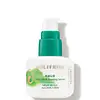What's inside
What's inside
 Key Ingredients
Key Ingredients

 Benefits
Benefits

 Concerns
Concerns

 Ingredients Side-by-side
Ingredients Side-by-side

Water
Skin ConditioningGlycerin
HumectantButylene Glycol
HumectantNiacinamide
SmoothingTranexamic Acid
Astringent1,2-Hexanediol
Skin ConditioningMethylpropanediol
SolventVinyldimethicone
Glycereth-26
HumectantIsononyl Isononanoate
EmollientEriobotrya Japonica Leaf Extract
Skin ConditioningMentha Viridis Extract
MaskingSodium Hyaluronate
HumectantPropanediol
SolventCetearyl Olivate
Sorbitan Olivate
EmulsifyingSodium Acrylate/Sodium Acryloyldimethyl Taurate Copolymer
Emulsion StabilisingIsohexadecane
EmollientHydroxyethyl Acrylate/Sodium Acryloyldimethyl Taurate Copolymer
Emulsion StabilisingAmmonium Acryloyldimethyltaurate/Vp Copolymer
Disodium EDTA
Carbomer
Emulsion StabilisingSorbitan Oleate
EmulsifyingTromethamine
BufferingSorbitan Isostearate
EmulsifyingBisabolol
MaskingPolysorbate 20
EmulsifyingPolysorbate 80
EmulsifyingPolysorbate 60
EmulsifyingEthylhexylglycerin
Skin ConditioningWater, Glycerin, Butylene Glycol, Niacinamide, Tranexamic Acid, 1,2-Hexanediol, Methylpropanediol, Vinyldimethicone, Glycereth-26, Isononyl Isononanoate, Eriobotrya Japonica Leaf Extract, Mentha Viridis Extract, Sodium Hyaluronate, Propanediol, Cetearyl Olivate, Sorbitan Olivate, Sodium Acrylate/Sodium Acryloyldimethyl Taurate Copolymer, Isohexadecane, Hydroxyethyl Acrylate/Sodium Acryloyldimethyl Taurate Copolymer, Ammonium Acryloyldimethyltaurate/Vp Copolymer, Disodium EDTA, Carbomer, Sorbitan Oleate, Tromethamine, Sorbitan Isostearate, Bisabolol, Polysorbate 20, Polysorbate 80, Polysorbate 60, Ethylhexylglycerin
Water
Skin ConditioningAloe Barbadensis Leaf Juice
Skin ConditioningHelianthus Annuus Seed Oil
EmollientGlycolic Acid
BufferingGlycerin
HumectantSodium Hydroxide
BufferingPropanediol
SolventGlyceryl Stearate
EmollientOpuntia Ficus-Indica Seed Oil
EmollientRubus Idaeus Seed Oil
EmollientCalophyllum Inophyllum Seed Oil
AntimicrobialCaprylyl Caprylate/Caprate
EmollientCetearyl Glucoside
EmulsifyingLeuconostoc/Radish Root Ferment Filtrate
AntimicrobialLactic Acid
BufferingPhytic Acid
Salicylic Acid
MaskingOryza Sativa Extract
AbsorbentRosa Canina Fruit Oil
EmollientSuperoxide Dismutase
AntioxidantCitrullus Lanatus Fruit Extract
Skin ConditioningVigna Aconitifolia Seed Extract
Skin ConditioningSodium PCA
HumectantLens Esculenta Fruit Extract
Skin ConditioningPyrus Malus Fruit Extract
Skin ConditioningCamellia Sinensis Leaf Extract
AntimicrobialCocos Nucifera Oil
MaskingTocopherol
AntioxidantSea Salt
AbrasiveSodium Lactate
BufferingCitric Acid
BufferingLecithin
EmollientPhenethyl Alcohol
MaskingPotassium Sorbate
PreservativeSodium Benzoate
MaskingMaltodextrin
AbsorbentXanthan Gum
EmulsifyingLeuconostoc Ferment Filtrate
AntimicrobialSodium Hyaluronate
HumectantSodium Carrageenan
Emulsion StabilisingDehydroacetic Acid
PreservativeSilica
AbrasiveBenzyl Alcohol
PerfumingSoybean Peroxidase
AntioxidantWater, Aloe Barbadensis Leaf Juice, Helianthus Annuus Seed Oil, Glycolic Acid, Glycerin, Sodium Hydroxide, Propanediol, Glyceryl Stearate, Opuntia Ficus-Indica Seed Oil, Rubus Idaeus Seed Oil, Calophyllum Inophyllum Seed Oil, Caprylyl Caprylate/Caprate, Cetearyl Glucoside, Leuconostoc/Radish Root Ferment Filtrate, Lactic Acid, Phytic Acid, Salicylic Acid, Oryza Sativa Extract, Rosa Canina Fruit Oil, Superoxide Dismutase, Citrullus Lanatus Fruit Extract, Vigna Aconitifolia Seed Extract, Sodium PCA, Lens Esculenta Fruit Extract, Pyrus Malus Fruit Extract, Camellia Sinensis Leaf Extract, Cocos Nucifera Oil, Tocopherol, Sea Salt, Sodium Lactate, Citric Acid, Lecithin, Phenethyl Alcohol, Potassium Sorbate, Sodium Benzoate, Maltodextrin, Xanthan Gum, Leuconostoc Ferment Filtrate, Sodium Hyaluronate, Sodium Carrageenan, Dehydroacetic Acid, Silica, Benzyl Alcohol, Soybean Peroxidase
 Reviews
Reviews

Ingredients Explained
These ingredients are found in both products.
Ingredients higher up in an ingredient list are typically present in a larger amount.
Glycerin is already naturally found in your skin. It helps moisturize and protect your skin.
A study from 2016 found glycerin to be more effective as a humectant than AHAs and hyaluronic acid.
As a humectant, it helps the skin stay hydrated by pulling moisture to your skin. The low molecular weight of glycerin allows it to pull moisture into the deeper layers of your skin.
Hydrated skin improves your skin barrier; Your skin barrier helps protect against irritants and bacteria.
Glycerin has also been found to have antimicrobial and antiviral properties. Due to these properties, glycerin is often used in wound and burn treatments.
In cosmetics, glycerin is usually derived from plants such as soybean or palm. However, it can also be sourced from animals, such as tallow or animal fat.
This ingredient is organic, colorless, odorless, and non-toxic.
Glycerin is the name for this ingredient in American English. British English uses Glycerol/Glycerine.
Learn more about GlycerinPropanediol is an all-star ingredient. It softens, hydrates, and smooths the skin.
It’s often used to:
Propanediol is not likely to cause sensitivity and considered safe to use. It is derived from corn or petroleum with a clear color and no scent.
Learn more about PropanediolSodium Hyaluronate is hyaluronic acid's salt form. It is commonly derived from the sodium salt of hyaluronic acid.
Like hyaluronic acid, it is great at holding water and acts as a humectant. This makes it a great skin hydrating ingredient.
Sodium Hyaluronate is naturally occurring in our bodies and is mostly found in eye fluid and joints.
These are some other common types of Hyaluronic Acid:
Learn more about Sodium HyaluronateWater. It's the most common cosmetic ingredient of all. You'll usually see it at the top of ingredient lists, meaning that it makes up the largest part of the product.
So why is it so popular? Water most often acts as a solvent - this means that it helps dissolve other ingredients into the formulation.
You'll also recognize water as that liquid we all need to stay alive. If you see this, drink a glass of water. Stay hydrated!
Learn more about Water